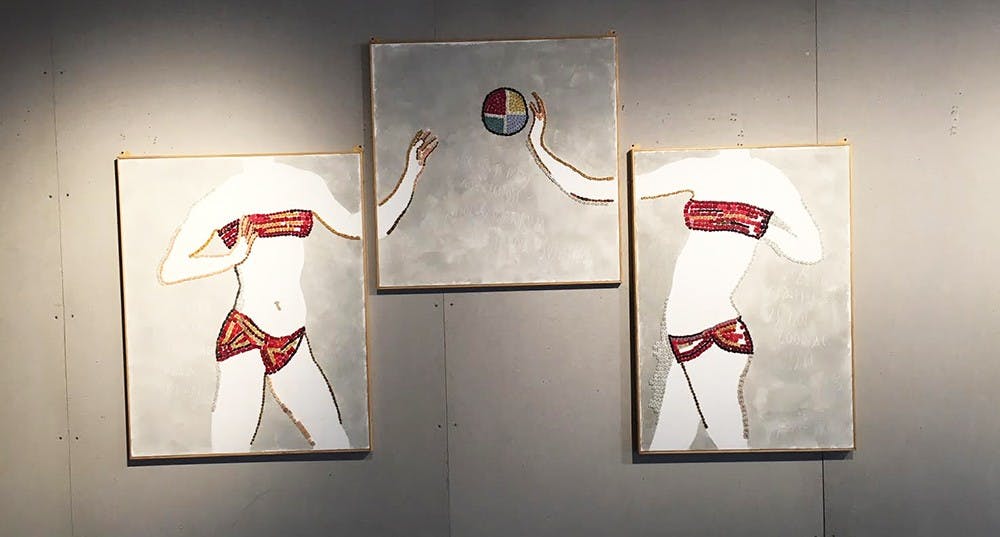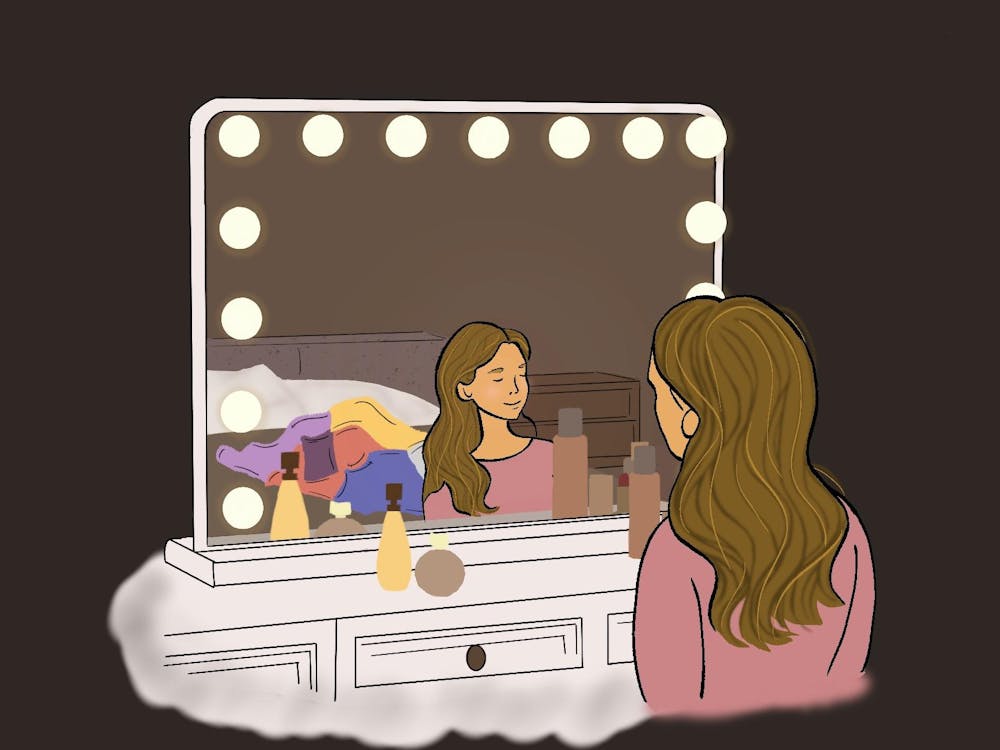Angela Lorenz wasn’t looking for a historical revelation. She had decided her next project would either be a monumental portrait or a watercolor book of images. However, by fortuitous circumstances, she stumbled upon an unknown history of female athletics.
Lorenz said she is fascinated by a collection of ancient mosaics entitled “The Bikini Girls,” originally discovered in Sicily in the 1950s. For decades, historical literature has described the mosaics as intended depictions of performers — girls playing instruments like rattles and the tambourine. Lorenz jumped at this opportunity to correct a historical error.
More importantly, she wanted to celebrate and highlight the accomplishments of female athletes who lived over 2,000 years ago. This led to the creation of “Victorious Secret,” a mosaic installation which now hangs in Campbell Hall.
Lorenz will be giving a lecture, entitled “Women Athletes as Family Status Symbol: Goals for Daughters in the Roman Empire,” Sept. 19 at 6 p.m. in Campbell Hall 158.
Arts & Entertainment spoke with the artist for a closer look at her creative process, inspiration and take on the importance of Title IX and female athleticism today.
A&E: Your first interaction with the mosaics came from coffee mugs and catalogues. Could you talk a little more about that?
Lorenz: Recently I was in the Pergamon Museum in Berlin, and these mosaics exist today in Sicily and you can visit them on the floor of this ancient Roman villa. They have nothing to do with the Pergamon Museum, and yet they have magnets of these women, and postcards ... I had the temptation to buy the magnets because it was so illustrated: this sort of idea of how people encounter these ideas out of context with no way of interpreting them.
A&E: Do you think the fact that the mosaics have been misinterpreted for so long reflects how we view female athletes in society even today?
Lorenz: So you have to consider these were discovered in the 1950s in Sicily, and even when certain archaeologists knew that they were athletes, many people writing about them and creating the tourist catalogues would sort of say, “Oh, well some people say they’re entertainers, some say they’re athletes — we think they’re entertainers.” Since they were discovered in the 1950s they were given the name “The Bikini Girls,” and that is already egging people on to think about what they’re wearing and not what they’re doing.
A&E: Initially you were doing research on Roman mosaics from Africa, Asia and Europe, and then you also had buttons for a separate portrait you were going to make. When did it click to fuse the two together?
Lorenz: Well, it was rather fortuitous. You hear people saying that in order to be an important artist or an important CEO you should forgo having children, but the reason I found out about the real interpretation of these mosaics and that the women were actually getting prizes and competing in actual athletic competitions, was because in the first grade, my daughter happened to become friends with the daughter of the archaeologist who conveyed this information to me.
I really enjoy using materials for a conceptual purpose, and the fact that these athletes are famous for what they’re wearing and not what they’re doing made it really appealing for me to create them out of things associated with ornament — so buttons [and] hairpins used to attach the buttons. In this sense the use of the buttons became even richer because they had purpose in the idea of the misinterpretation of these athletes.
A&E: When people see your exhibit, what do you hope they get out of it?
Lorenz: My own particular way of doing art is very conceptual and completely based on research — information from history. We can talk about the terrible misinterpretation of the mosaics, but we can also highlight just how incredible it was that there were international elite games for women 2,000 years ago. I think we can celebrate this past that not enough people know about — that ancient families gained in status by having their daughters compete in these competitions.
A&E: For female athletes who come see your exhibit, what message do you want them to specifically take away from this?
Lorenz: At Yale, the women’s tennis team used it as a bonding event. We talked about sports because I played a lot of sports as a child. Women still have struggles today in athletics and social rights and human rights. But I think it’s just nice for athletes to realize that this has been going on. I mean, that said, maybe athletes can feel grateful today that they do have laws like Title IX, so that it helps them achieve their goals.
I read lot during the Rio Olympics, and there was one article that talked about the impact of Title IX in terms of the number of medals that Americans received in the summer Olympics, because since 1972 there’s been a law guaranteeing women’s athletic programs at universities. It’s paying off. Over the years, more and more women have been able to participate and train. So [the exhibit is] definitely celebrating women and sports, and I would hope the athletes feel good about that.
A&E: What sports did you play in your childhood?
Lorenz: I played ice hockey and tennis mostly. I played [ice hockey] with boys on boys’ teams, and sometimes I was the only girl in the entire league. I played through my senior year of high school, and I went to Brown University and did preseason my fall term of my freshman year, but there was a problem. There was only one rink and the men got to practice every afternoon, and the women had to practice at night. So if you played on the women’s ice hockey team you could never go to a lecture, concert or dinner with anybody that wasn’t on the team.
But I felt as if I had just been playing sports my whole life, and I had come to college to broaden my horizons. If I played ice hockey I would never be able to do many other things at Brown because no one had the bright idea that maybe we could alternate, and the women could practice in the afternoon and then men could practice in the evening. So it really did have a big impact on my decision not to play sports.
A&E: What was your favorite part of the entire process of creating “Victorious Secret?”
Lorenz: Initially, I kept the buttons round and they looked like the wrong association. So then I had to cut them into squares, but that was a problem because a lot of the stock that I had brought over to Maine, where they were constructed, didn’t work anymore. When I tried to break them either the plastic resin was so hard you couldn’t, or they would break apart. I enjoy the troubleshooting. I like to make things. I need to physically work with different materials. That’s why I like to take information and transform it into art, because I’m a maker at heart.
Correction: An earlier version of this article misquoted Lorenz saying, "This sort of idea of how people encounter these ideas out of contact with no way of interpreting them," and, "The fact that these athletes are famous for what they’re wearing and not what they’re doing made it really appealing for me to create them out of things associated with ornaments." In the interview, Lorenz referred to "context," not "contact," and "ornament," not "ornaments."







